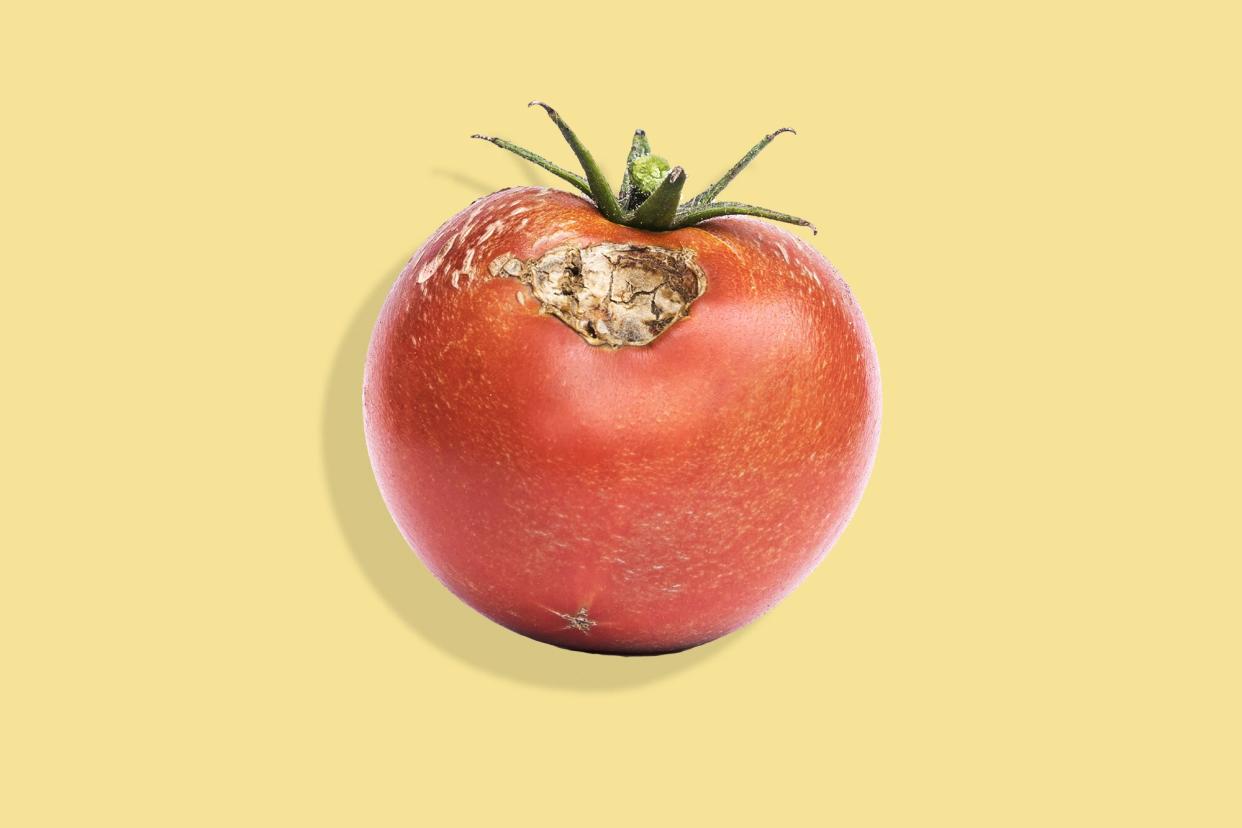Is It Safe to Eat a Bruised or Moldy Tomato?

Getty Images
If you went a little overboard with your tomato haul at the farmers' market, you might ask yourself as you stare at your bounty: What do I do if some of the tomatoes have mold on them? And, is it OK to eat a bruised or moldy tomato? Read on to for the answers and more!
Related: 20 Tomato Salads in 15 Minutes or Less
How to select the freshest tomatoes
Preventing your tomatoes from getting overly ripe or even moldy starts when you're shopping. Here are a few things to be mindful of:
Their skin should be uniform and smooth without bruises or cracks that are too deep
They should be bright in color without any pale spots by the stem
Your tomatoes should be free from bruises or any soft sections
"Tomatoes are at their taste peak as they soften. If you intend to use the tomato right away, look for a slight give as you gently squeeze. If you're not sure when you'll use it, choose a more firm tomato. That one will ripen over the next few days, offering you some time to find the perfect recipe or other ingredients," says Tomatomania! founder Scott Daigre.
Holding them in your hand can definitely help; just don't squeeze too hard! Small tomato varieties like cherry and grape should be firm but not too hard. It will be more obvious in large tomatoes when there's a bruise, so make sure they feel heavy but not soft.
Is it OK to eat a bruised or moldy tomato?
Bruised
Bruised tomatoes won't be soft all over, but may be soft in certain spots. You can easily cut away the affected portion to still enjoy uniform slices for your favorite sandwiches, but it should be done as soon as possible so the entire tomato doesn't become too soft.
"Don't let this go on too long before you do that, or the entire fruit will be spoiled. A slight bruise won't hurt as you cook and prepare them, but a super-soft or moldy section is just no good," says Daigre.
Moldy
Once you've spotted mold on your tomatoes, it's probably time to say goodbye. Even if you only spot a bit of mold on the outside, there could be more mold lurking underneath the surface of your tomato, according to the USDA. If only one tomato in the bunch is moldy, compost or discard it and inspect the others for use as soon as possible.
Overripe
Overripe tomatoes will be on the soft side all over and more difficult to cleanly cut. However, they're still perfectly safe and delicious to eat!
Related: The Easiest Way to Peel Tomatoes
Do tomatoes on the stem last longer?
Regardless of whether or not your tomato is on the stem when you bring it home, it will ripen! However, the stem can protect your tomato from having moisture or bacteria enter it.
How long your tomato will last at home before bruises or moldiness occurs also has a bit to do with size. "Smaller or medium-sized varieties are often showcased on the stem while larger varieties are not usually offered this way," says Daigre. "The smaller group will generally last a bit longer than the larger or huge thin-skinned beefsteaks. So, for a longer shelf life choose a smaller tomato."
How to store tomatoes
Tomatoes can be quite finicky and don't like too hot or too cold of a climate when being stored at home. Especially if you're planning to eat them fresh and not cook with them, keep your tomatoes out of the refrigerator. Similarly, you don't want them to be in direct sunlight on your countertop or near any heat.
Instead, try this hack from Daigre: "Set them out in single layers with some space between them, stem-side down. The scar that is evident where the fruit was attached to the stem is your clue here."
Uses for bruised and/or overripe tomatoes
Just because they won't hold up in certain dishes, that doesn't mean your bruised and overripe tomatoes don't have other uses. "Some tomatoes we might judge as overripe could actually be at their peak of taste," suggests Daigre.
If you still don't think you'll get to them fresh, try freezing your tomatoes! "You can freeze them whole, cut or smashed. Retrieve and thaw them for a sauce. Cut off bruises or any unhealthy-looking sections before you get started," says Daigre.
Related: How to Freeze Fresh Fruits and Vegetables
Since bruised or overripe tomatoes won't slice as well into sandwich-ready pieces, getting creative with recipes which require blending, sautéing or roasting is a good way to go. Try slow-roasting them, turning them into a refreshing summer gazpacho, tossing them into a slow cooker for an easy marinara sauce or making a simple fresh tomato salsa.
Bottom line
If you happen to find some bruised tomatoes in your tomato haul, no worries! Cut out the bruised areas and enjoy the rest of the tomato. Since bruised and overripe tomatoes tend to be softer in texture, take that into consideration when choosing how to prepare them. But if you spot mold, it's time to toss the affected tomatoes.
Related: 24 Recipes for Overripe Tomatoes

